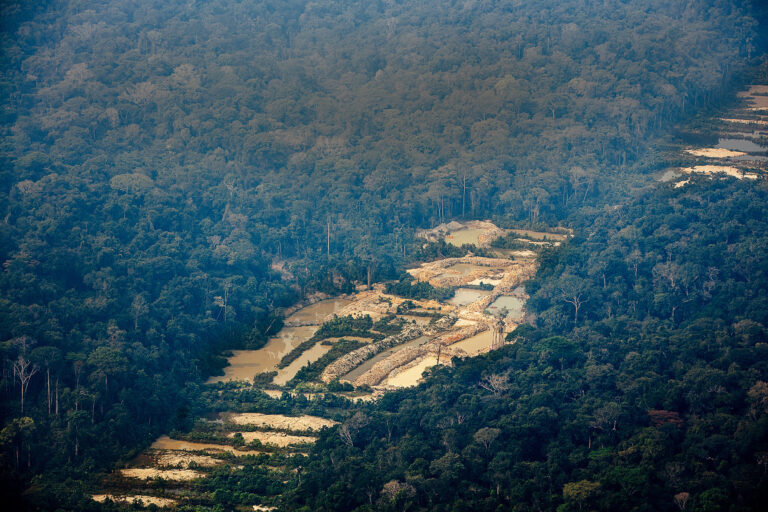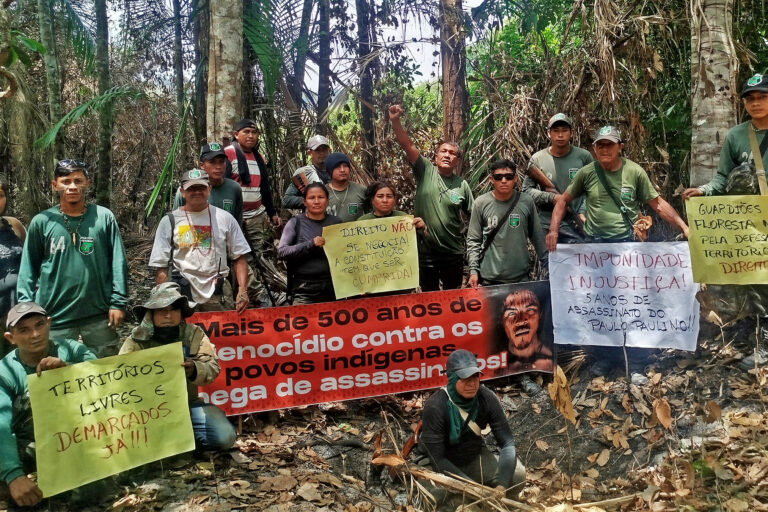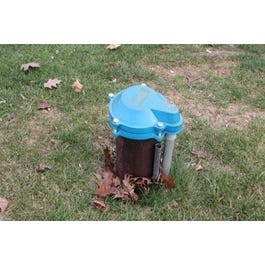
[ad_1]
- There’s a planned start date to remove illegal gold miners from the Munduruku Indigenous territory, where they have long decimated the Munduruku people’s health and the Amazon ecosystem with mercury contamination, prosecutors share with Mongabay.
- The date and removal operation remains confidential, with government sources gathering data on the areas most affected in the region. The government may share more information during a press briefing in early November, while some news sites suggest the operation will begin in a few days and involve the defense ministry.
- The Supreme Court and Indigenous peoples have called for the removal of the miners from the region for years, to little avail. Meanwhile, other sources say the government had to prioritize crises in other Indigenous lands like the Yanomami territory.
- According to a researcher, the expulsion of gold miners from another Munduruku territory, the Sawré Muybu Indigenous land, cannot begin until the president recognizes the territory.
SÃO PAULO — After years of delays in protecting the Munduruku Indigenous people from illegal gold mining and mercury use decimating the Tapajós River Basin, Brazil’s independent public prosecutors said there’s now a planned start date to remove the miners from the Munduruku Indigenous territory. Though the precise date and operation remain confidential, stakeholders in the government and communities are gathering preliminary data to plan the miners’ expulsion, sources share with Mongabay.
The Munduruku and their ancestral lands in the Amazon rainforest have dealt with illegal gold miners for decades. When miners use mercury to obtain gold from the ore, the toxin flows down the river, affecting communities that drink the water and consume its fish. From babies to the elderly, studies have detected the presence of this heavy metal in their bodies. Mercury impacts the central nervous system, causing brain damage and deformities and crossing the placental barrier to reach the fetus.
The Munduruku Indigenous territory was officially recognized two decades ago, but miners still came. Despite a 2020 Supreme Federal Court order for the federal government to expel miners in Munduruku and other Indigenous lands “in a more critical state” (with a request made again in 2023), very little has been done so far.
In addition to the STF, the Federal Public Prosecutor’s Office and the Pará Public Prosecutor’s Office have requested the removal of the illegal miners from the Munduruku land for years. The land, measuring 2.4 million hectares (5.9 million acres), is the second-largest area of illegal mining of any Indigenous territory in Brazil and is home to 6,500 people.
“The [Indigenous] communities are demanding action,” said Thaís Medeiros da Costa, a federal prosecutor for the Pará Public Prosecutor’s Office.
The 2022 elected president, Luiz Inácio Lula da Silva, first focused on removing illegal occupants from the Yanomami territory (then occupied by around 20,000 miners) and the Apyterewa and Trincheira Bacajá lands (the latter occupied by land grabbers and cattle ranchers).
“The current administration took over a destroyed Brazil and had to prioritize the most serious case, the Yanomami territory. But if it had successfully carried out the eviction within the timeframe foreseen, the other land cases would have been more advanced,” said Luísa Molina, deputy coordinator of the Xingu Program at the Socioenvironmental Institute (ISA).
“This work requires cooperation, and there was a lack of logistical support from the military, making the process longer than expected and necessary.”
The operation
In a note to Mongabay, the Ministry of Indigenous Peoples stated, “the federal government will comply with the court decision. However, this is a confidential operation, so we are not authorized to release dates before the operations begin [in the Munduruku land].”
A coordination meeting to plan the operation will be held on November 7, 2024, stated a press briefing by the federal government. According to Reuters, the operation will involve federal bodies from the Defense Ministry to Funai (Brazil’s Indigenous affairs agency).
Also contacted by Mongabay, Ibama, the federal environmental agency, said that the withdrawal process “will be coordinated through the Indigenous Lands Removal Committee, created to comply with the STF decision. In this context, Ibama’s actions will follow the committee planning.”

The agency added that it is essential to complete the removal of miners from the territory before any environmental monitoring activity is implemented.
Academic studies suggest the predatory (top of the food chain) fish species commonly consumed by the Munduruku from a young age have the highest levels of mercury due to their consumption of other contaminated fish. The black piranha (Serrasalmus rhombeus) had the highest level of mercury among species, one paper analyzed.
“The removal of invaders is a more immediate, short-term act, but there is also a need to identify the most affected populations and the treatment they will be given,” said Costa, of the MPF-PA, who is referring to all contaminated Indigenous lands in the Tapajós River Basin.
“All of this requires data,” she continued. “Much of the information produced comes from academia, but it does not translate into official data that feeds systems such as SISSOLO [Health Surveillance Information System for Populations Exposed to Contaminated Soil] and BDNAC [National Database on Contaminated Areas]. The government needs to generate data to implement public policies.”
This month, in November, Ibama and ICMBio, the agency for conservation units, will present the initial data of the most contaminated areas in Munduruku lands — whether recognized or not — of the Tapajós basin. This will be presented at the Pará Forum to Combat the Impacts of Mercury Contamination in the Tapajós, created last year by the federal and state prosecutor’s offices and civil society organizations. Indigenous representatives, as well as from the Pará Department of Environment and Sustainability, are participating in the discussions on the location of contaminated areas, how to combat the presence of mercury in rivers, and the treatment of Indigenous people.
The Ministry of Health reports that between January and October 2024, 381 cases of “toxic effects of mercury and its compounds” were registered in the Indigenous Health Care Information System (SIASI) in the Mundurku and Sawré Muybu lands.
In response to questions about what the Ministry of Health is doing regarding mercury contamination, its communications office stated that “efforts are being made” to implement the Minamata Convention on Mercury to regulate and eradicate mercury use.
“The Ministry is reviewing the Health Sector Plan with representatives from academia and civil society in the Mercury Working Group. The goal is to raise demands for Indigenous health and develop the strategic plan for measures of care, surveillance and comprehensive health promotion for populations exposed to mercury.”
Another Munduruku land
According to civil society and human rights sources, formal demarcation is critical to protecting Munduruku lands from miners.
While the Munduruku Indigenous Territory is recognized, the Sawré Muybu Indigenous land (also impacted by significant mercury contamination) has been waiting for demarcation and official recognition for over ten years.

Molina of ISA noted that, although they face the same problem with illegal miners and are awaiting their expulsion, the two Indigenous lands have different land tenure situations.
“According to the Brazilian law, the removal of invaders from an Indigenous land can only be done when it is officially recognized by presidential decree, which is the case of the Munduruku land, but not the Sawré Muybu. That is why it is essential that the government finish the demarcation of the second territory soon.”
This suggests that removing miners from the Sawré Muybu Indigenous land will begin after the president has recognized the territory.
On September 25, 2024, eleven years after Funai completed the identification of the territory for demarcation, the Ministry of Justice and Public Security declared the area the permanent possession of the people in the Sawré Muybu land.
The remaining steps are for Funai to demarcate the boundaries administratively and for President Lula to recognize the territory officially. Mongabay was not given a date for when this will be completed.
Banner image: Illegal mining in the Munduruku Indigenous Territory in 2020. Image by Marizilda Cruppe/Amazônia Real/Amazon Watch.
Sieged by mining and megaprojects, the Munduruku push for land rights in the Amazon
Citations
De Vasconcellos, et al. (2021). Health Risk Assessment of Mercury Exposure from Fish Consumption in Munduruku Indigenous Communities in the Brazilian Amazon. International Journal of Environmental Research and Public Health, 18(15), 7940. https://doi.org/10.3390/ijerph18157940
Kempton, J. W., et al. (2021). An Assessment of Health Outcomes and Methylmercury Exposure in Munduruku Indigenous Women of Childbearing Age and Their Children under 2 Years Old. International Journal of Environmental Research and Public Health, 18(19), 10091. https://doi.org/10.3390/ijerph181910091
Bello, T. C. S., et al. (2023). Mercury exposure in women of reproductive age in Rondônia State, Amazon region, Brazil. International Journal of Environmental Research and Public Health, 20(6), 5225. https://doi.org/10.3390/ijerph20065225
De Oliveira, et al. (2021). Neurological impacts of chronic methylmercury exposure in Munduruku Indigenous adults: somatosensory, motor, and cognitive abnormalities. International Journal of Environmental Research and Public Health, 18(19), 10270. https://doi.org/10.3390/ijerph181910270
FEEDBACK: Use this form to send a message to the author of this post. If you want to post a public comment, you can do that at the bottom of the page.
[ad_2]
Source link







